Environmental Engineering G.A.M.E.S. Encourages Girls to Think/Design Green
August 12, 2013
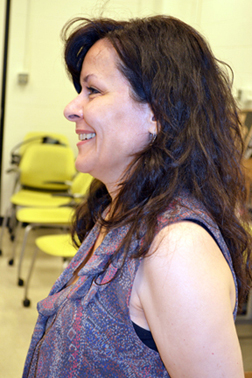
Dr. Sotiria Koloutsou-Vakakis,Co-Director of the Environmental Engineering and Sustainability G.A.M.E.S. camp, enjoys one of the sessions.
For high school girls whose dream is to save the planet, the 2013 Environmental Engineering and Sustainability G.A.M.E.S. Camp was a perfect fit. The one-week camp addressed many aspects of environmental engineering, including water quality, air quality, waste, renewable energy, and sustainability. For the final project, the girls dreamed up a concept for a sustainable campus, then incorporated engineering and economic aspects to create an energy efficient dorm.
In its second year of operation, the Environmental Engineering and Sustainability G.A.M.E.S. Camp is the brainchild of Sotiria Koloutsou-Vakakis, co-director of the camp along with Professor Timothy Strathmann. Vakakis actually got the idea to start the camp because her daughter participated in one of the G.A.M.E.S. camps a couple of years ago. And liked it.
"What a nice idea," Vakakis thought. "We did not have a camp in environmental engineering at that time," she continues, "and I said, 'That's a good opportunity for us to offer one in Environmental Engineering.'"
(For the record, Vakakis' daughter participated in G.A.M.E.S. again this year, but in a different track. "Not in Mom's camp," confides Vakakis, who was ok with that.)
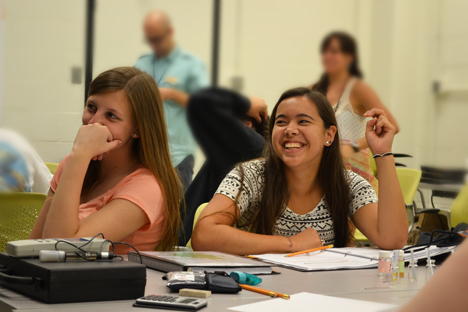
Two participants in the 2013 Environmental Engineering G.A.M.E.S. camp enjoy a session about water purity.
The 14 girls who attended the 2013 version of the camp experienced a few changes from the first year. Besides simplifying the schedule to allow more time for core ativities, the team of instructors worked to make the camp even more engaging for the girls by replacing some of the computer exercises with hands-on activities.
First, campers were introduced to the concept of Sustainability, including Systems Thinking and Life Cycle Analysis. To understand decision making for building sustainable communities, campers designed a sustainable campus, considering environmental, economic, and social components. They were also introduced to the engineering design process and what Environmental Engineers do, which starts with understanding how pollutants get generated and are chemically or biologically transformed in the environment, and ends with designing cleaning technologies for human-produced pollutants.
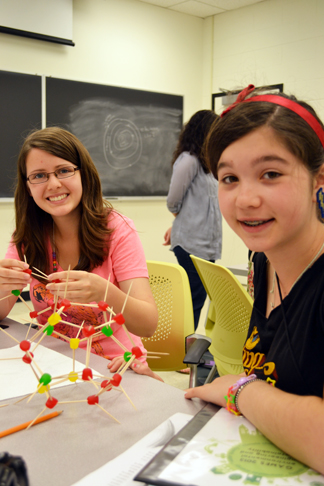
Campers build a molecular model of crystalline silicon during the solar panel session.
Campers leaned about Renewable Energy. They toured the Illinois Sustainability Technology Center, learned about biofuels, and did a calorimetry lab experiment. After learning about power and energy, they designed and built their own windmills, then estimated how much energy they could deliver. They were introduced to climate change, learned how solar panels are constructed, and measured their power output under different lighting conditions. The campers also learned about the importance of good air quality for health, sources and fates of air pollutants and air pollutant cleaning technologies, and the importance of the nitrogen cycle for air and water quality. They were also introduced to environmental data visualization, a tool for making decisions regarding the environment.
As an intro to designing an energy efficient dorm, they toured the Business Instructional Facility (Platinum LEED-certified by the U.S. Green Building Council) with its roof gardens, solar panels, and environmentally friendly materials. After learning about the increasing importance of water, campers measured drinking water quality indicators such as pH, alkalinity, and dissolved salts and/or metals, and had fun designing a low cost water filter to achieve the best water quality.
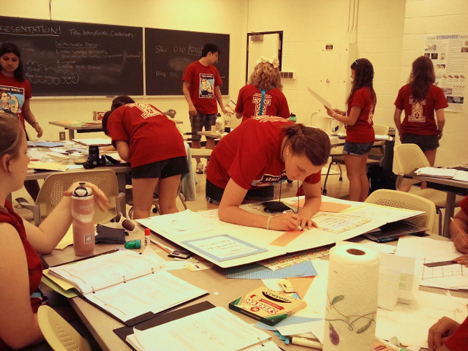
Campers create posters for the final presentation. (Photo courtesy of Sotiria Koloutsou-Vakakis.)
The final event on Friday afternoon was a competition where the girls made presentations of their sustainable campus and energy efficient dorm designs. There were winning teams for best designs and one for the best presentation, including teamwork.
According to Vakakis, girls who choose their camp are uniquely motivated. Typically, high school girls who attend G.A.M.E.S. want to find out if engineering is for them; however, Environmental Engineering girls attend camp because they are also "very interested in saving the planet."
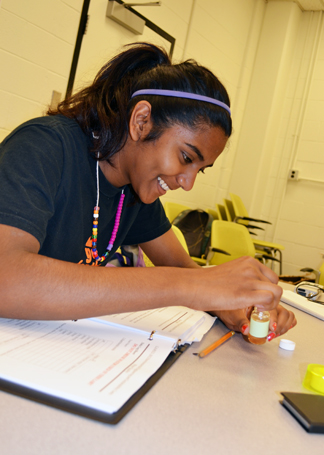
Camper uses a PH strip to test a water sample during a hands-on activity exploring water quality indicators.
"They have some strong ideology that comes with them here to our camp," she continues, "so we try actually to feed that enthusiasm they have. They come excited about the topic, and then we don't want to land them in the mundane things that sometimes engineers have to do, but just to say, 'Yes, these are the big goals, and this is how environmental engineers work to achieve them.'"
According to Vakakis, the camp's emphasis is placed on how the field of environmental engineering is evolving, rather than where it has traditionally been. The goal is to communicate what environmental engineers do now within the framework of sustainability and systems thinking.
For example, an important part of the camp's emphasis is prevention:
"Ok, when you have waste," explains Vakakis, "it is a little bit late when you to try to clean it up after it happens. It's much more efficient to not allow it to happen in the first place."
She goes on to elaborate, explaining that prevention is key to sustainability.

Timothy Strathmann (upper left), Co-Director of the camp, and Shijie Leow, a graduate student instructor, enjoy the water quality session.
"In sustainability, you have to look at the whole system, at interactions, how they work, understanding how the whole system works. You can take it step by step, and work first on pollution prevention. And if you can't prevent it all, you have to clean it up, of course. In the meantime, you have done most of the work with prevention. But this requires that you understand how the whole system works, and not only focus on the tailpipe."
For girls bent on saving the planet, the camp's emphasis on sustainability explored some practical ways their dream could become a reality. This is most likely why half of the girls indicated they were seriously considering environmental engineering as a future college major. Thus,Vakakis sees G.A.M.E.S. as an opportunity to recruit girls into her field.
"For me, I just believe in the concept of bringing in young girls and letting them know what the different fields of engineering are about…a way for the girls to find out what we're doing. It's an opportunity for us to recruit those girls who are very smart, and, from what we found out both years, are very motivated and very interested."
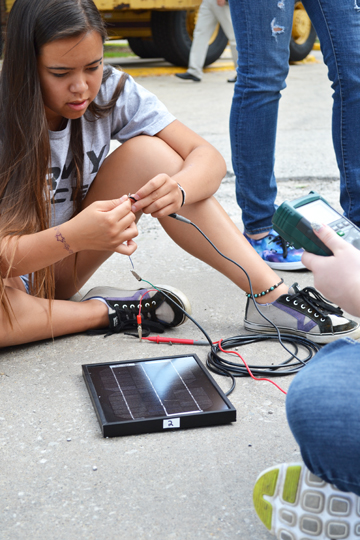
G.A.M.E.S. camper sets up a solar panel for a hands-on activity to measure is power output under a variety of lighting conditions.
In addition, aware that girls sometimes feel intimidated regarding their ability to succeed in STEM fields, Vakakis sees the camp as an opportunity to bolster the confidence of girls who attend and convince them that they have what it takes to succeed in engineering.
"For girls, we have a higher goal, because they don't feel as confident in their math and science skills. So this is an opportunity for us to tell them, 'Hey, you can do it, and you have great ideas. You have the skills. It's something that you can learn. You're not less gifted than somebody else; you can do it.'"
So is her goal to recruit girls into STEM careers, or specifically environmental engineering? Replies Vakakis, "First of all, into STEM, and if it advances into Environmental Engineering, we'll be totally happy."
Drs. Vakakis and Strathmann wished to express their appreciation for the Environmental Engineering graduate students who made significant contributions to the camp:
- Srinidhi Balasubramanian(Sustainability, Visualization of Environmental Data, Air Quality, & camp coordinator)
- Victoria Boyd (Climate Change, Renewable Energy, & camp coordinator)
- Jong Kwon Choe (Water Quality)
- David Johnsen (Air Pollution Control)
- Shijie Leow (Renewable Energy)
- Sahid Rosado (Water Quality)
- Derek R. Vardon (Renewable Energy)
Story and photos by Elizabeth Innes, Communications Specialist, I-STEM Education Initiative.
More: 8-12 Outreach, Environmental Engineering, GAMES, GAMES: ESE, Summer Camp, Sustainability, Women in STEM, 2013
For additional I-STEM articles about 2013 G.A.M.E.S. camp, see:
- 2013 G.A.M.E.S. Camp Gives Girls a Taste of Engineering—and College Life
- G.A.M.E.S. Camp Seeks to Navigate Girls into Aerospace Engineering
- G.A.M.E.S. Campers Experience Bioengineering—and Have Fun
- GLAM Seeks to Capture Girls' Imagination About Materials
- G-BAM Sends Campers This Message: Girls Make Awesome Engineers
- GLEE Campers Learn How Electrical Engineering Impacts Their Everyday Lives
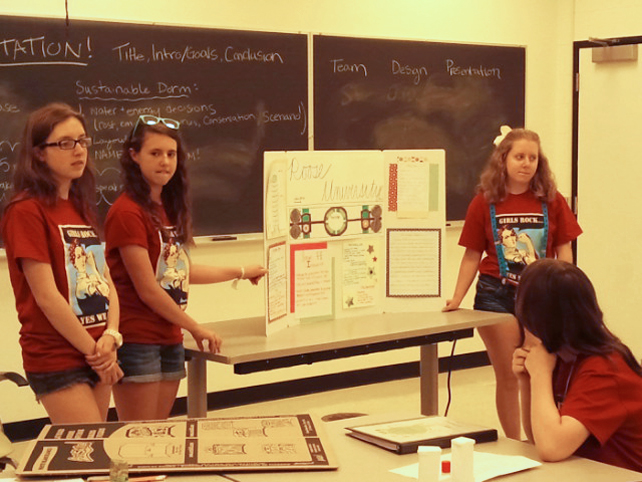
Campers present their project at the camp's final event, a poster presentation. (Photo courtesy of Sotiria Koloutsou-Vakakis.)
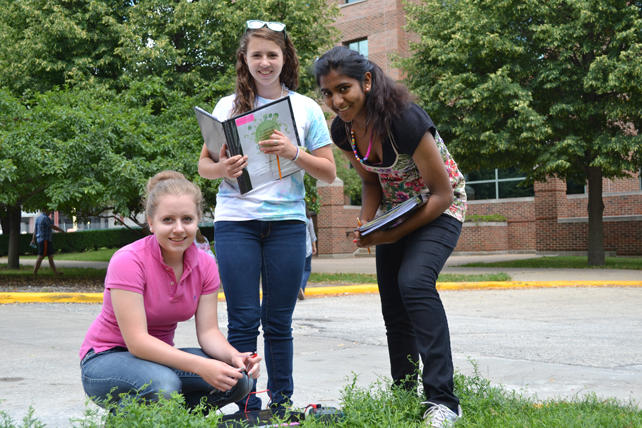
Campers measure the power output of a solar panel during one of the camp's sessions.













.jpg)
















